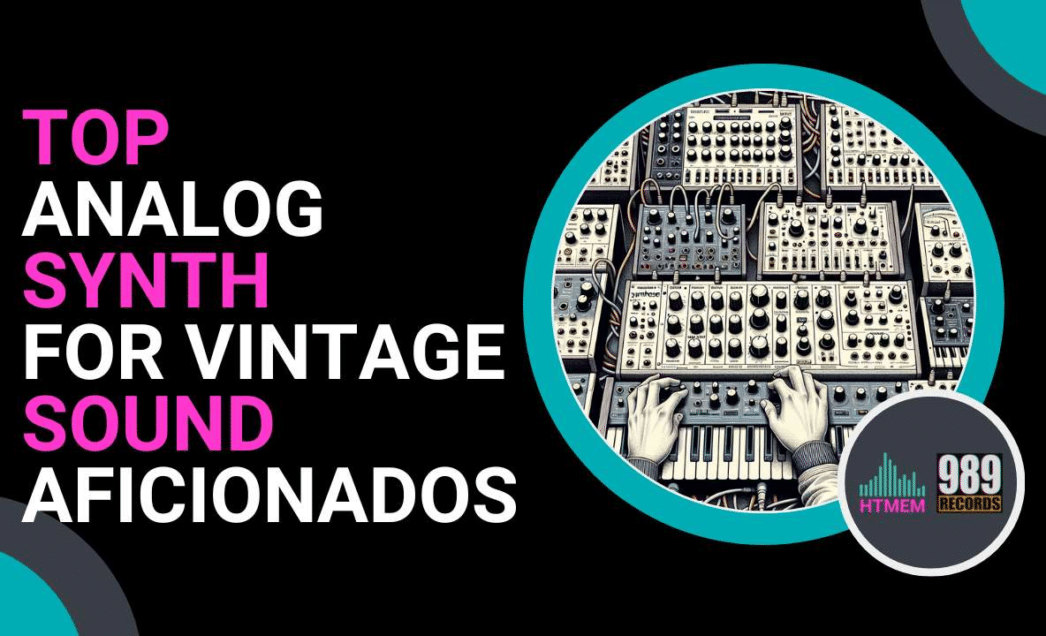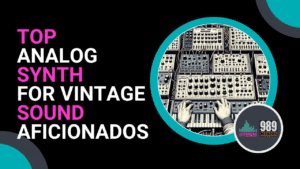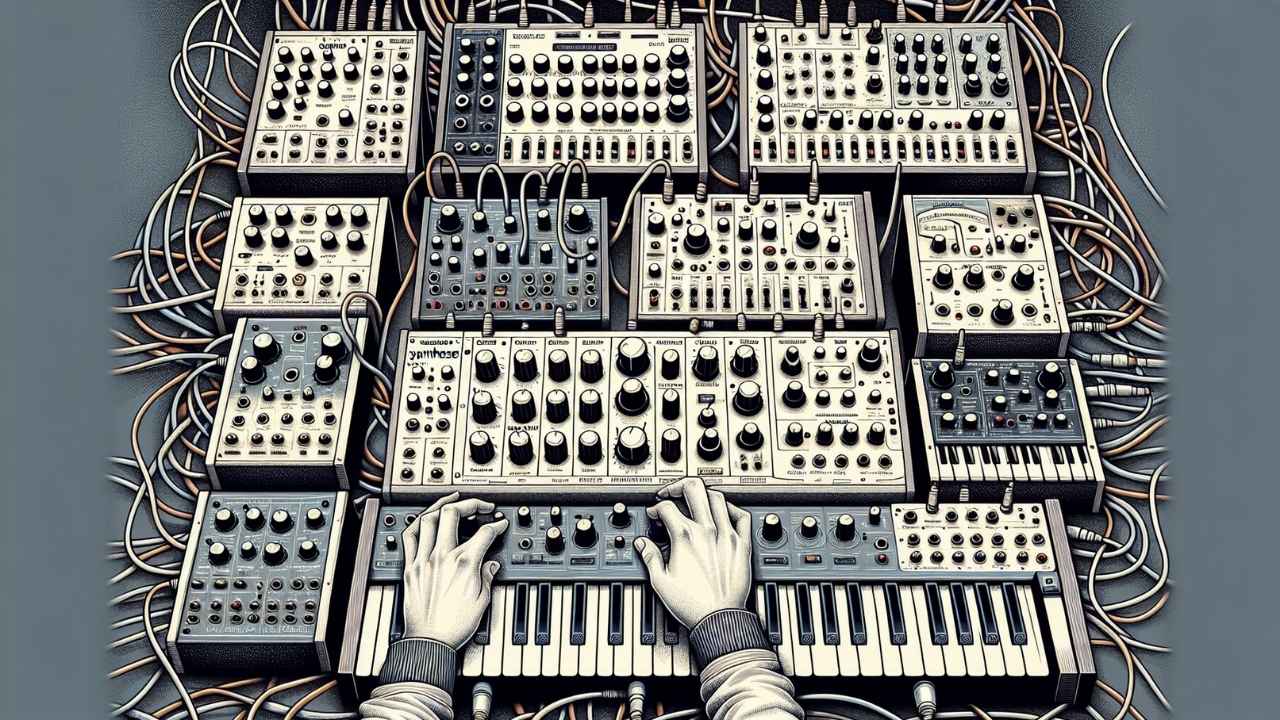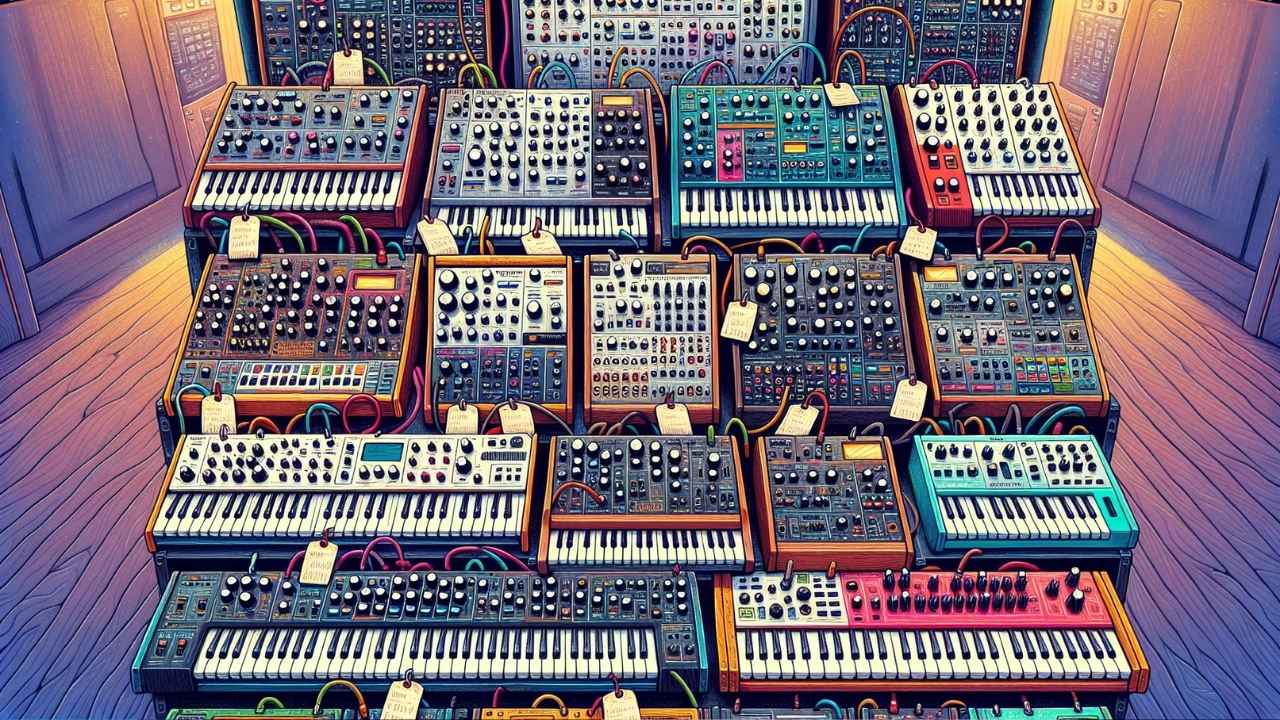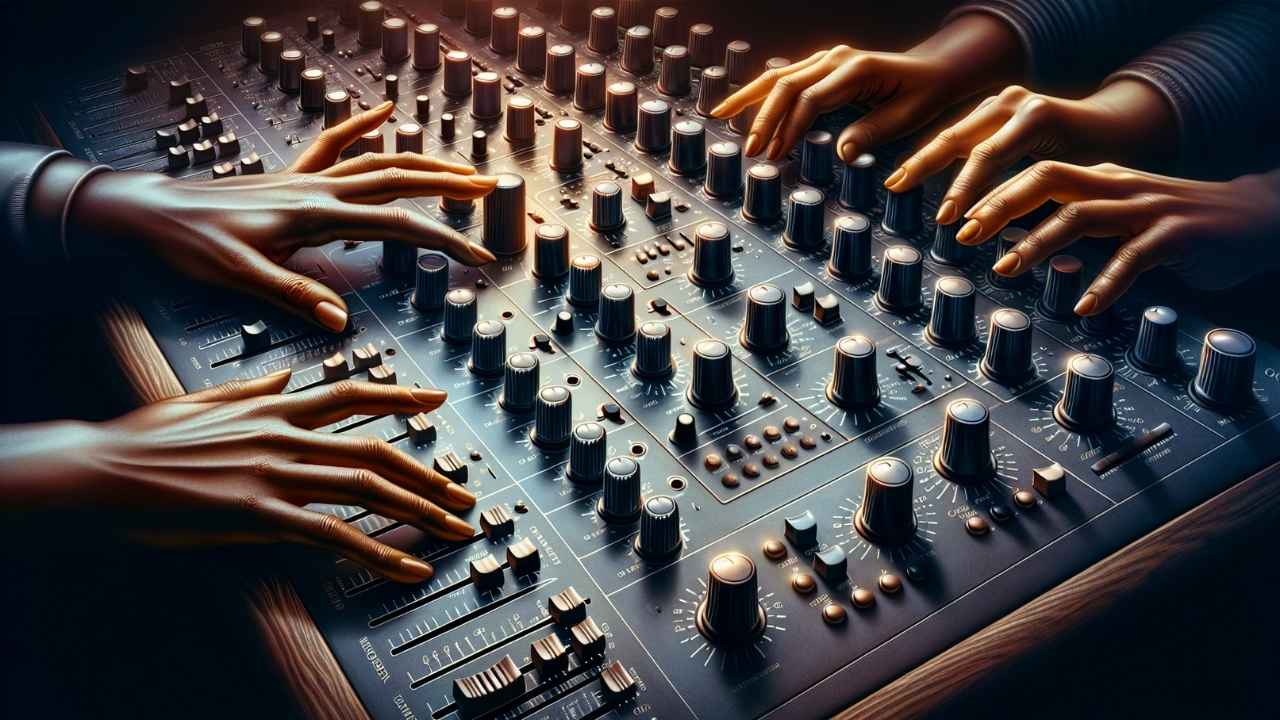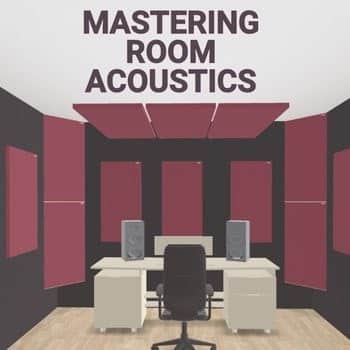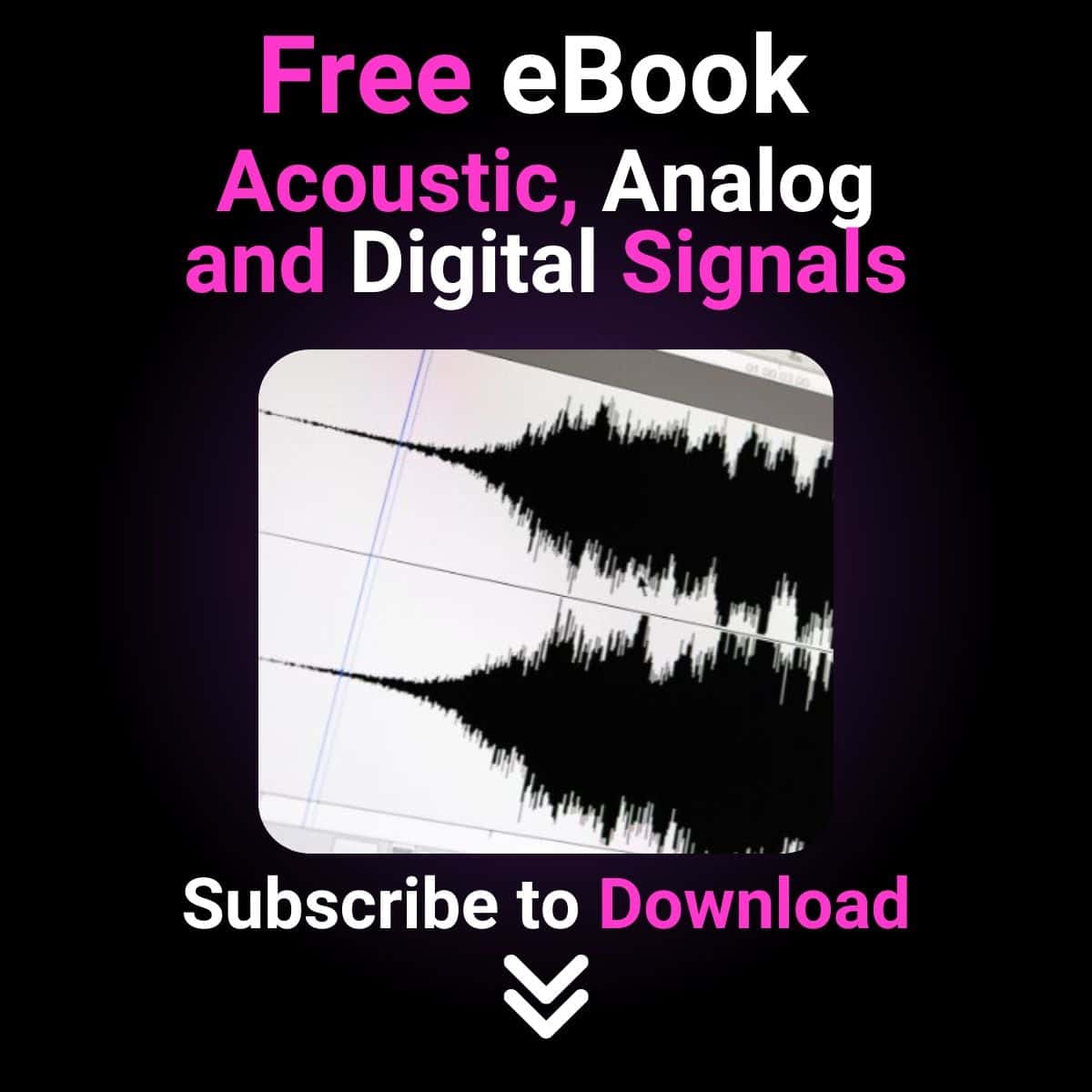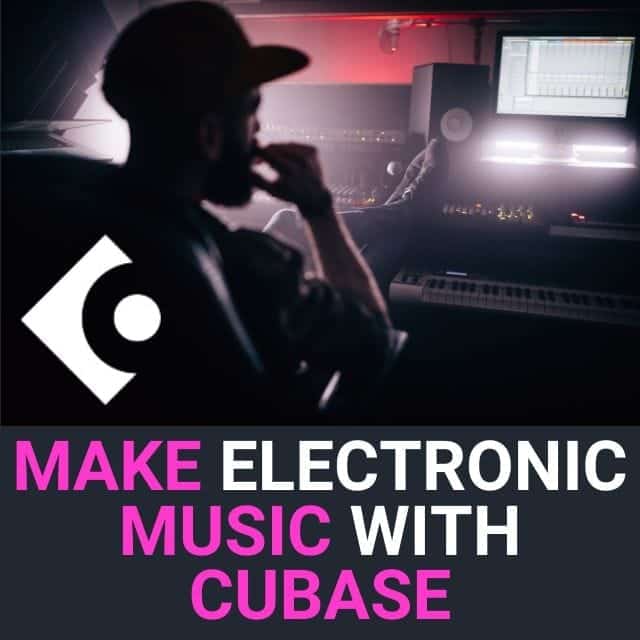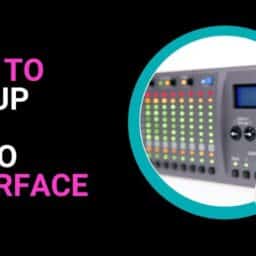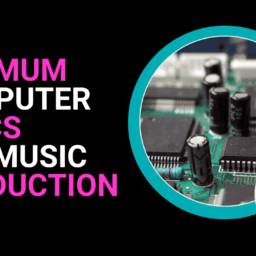Navigating the world of analog synthesizers is an exciting journey into sound.
Discover the finest vintage sound engines and the artists who wield them, as well as how to choose and use the right synth for your music. Enjoy the warm, rich tones only analog can offer with this HTMEM guide.
Key Takeaways
- Analog synthesizers, renowned for their ‘warm’ and ‘full’ sound, are gaining popularity due to a resurgence in interest and more affordable manufacturing, connecting musicians to the instrument’s rich history and hands-on creative expression.
- A variety of analog synthesizers, ranging from entry-level to high-end models, satisfy different skill levels and budgets, with modern options providing different features, such as polyphony and advanced modulation capabilities like voltage-controlled amplifiers and envelope generators. Monophonic synthesizers, which can only play one note at a time, are often favored for basslines and lead parts. Most polyphonic synthesizers can also be set to monophonic mode, offering additional flexibility for sound design.
- In choosing an analog synth, it’s essential to consider features such as sound quality, hands-on control, modulation capabilities, and how the instrument can integrate with other music production tools to expand creative possibilities.
Table of Contents
Understanding Analog Synthesizers
Top Analog Synths for Various Budgets and Skill Levels
Essential Features to Look for in an Analog Synth
Analog Synth Accessories and Integration
Iconic Analog Synth Sounds and Artists
Summary
Frequently Asked Questions
Understanding Analog Synthesizers
Welcome to the electrifying realm of analog synth and analog synthesizers, where each knob twist and switch flick transforms airwaves into auditory masterpieces. Sounds exciting? Let’s check this out!
Analog synthesizers use analog circuits and signals to generate sound, offering a distinct sonic palette that digital instruments often strive to emulate. In an age where software synths and digital soundscapes dominate, the organic, raw sounds of analog circuits are experiencing a renaissance. Manufacturers are now leveraging cheaper manufacturing methods and a renewed interest in these classic synths, making them more accessible and sought after than ever before.
Key components like voltage-controlled amplifiers and envelope generators play a crucial role in shaping the sound, adding dynamics and expression to the music.
Analog synthesizers serve as more than just musical instruments. They connect us to the past, facilitate current music creation, and light the way for the future of composition. From the warmth of a Moog bass to the crispness of a Korg lead, analog synths offer a hands-on experience that is both intuitive and inspiring. They serve as a canvas for musicians to paint their sonic landscapes, with every analogue filter and oscillator adding a stroke of genius to the masterpiece that is analog synthesis.
The History of Analog Synths
The progression of analog synthesizers offers an intriguing narrative of innovation and creativity. These instruments have transformed from rudimentary mechanical devices to sophisticated electronic instruments that stand at the heart of modern music production. The introduction of voltage-controlled oscillators and filters marked the innovation in analog synthesizers during the 1960s. The Minimoog, launched in 1970, was a game-changer; it was the first portable and accessible synthesizer with a built-in keyboard, bringing the magic of synthesis to a broader audience. As the decade progressed, companies like Oberheim and Sequential Circuits pushed the envelope with the OB-X and Prophet-5, introducing the world to the wonders of polyphony and programmability.
This era of rapid innovation laid the groundwork for the analog revival we’re witnessing today. Musicians and producers are rediscovering the unique sonic qualities and hands-on experience that these classic synths offer. Analog synthesizers fell out of favor in the 1980s as digital synthesizers became more popular. It’s not just about the sound; it’s about the connection to a rich history of music-making—a journey through time powered by oscillators and analog filters.
The Legacy of Analog Synthesizers
Analog synthesizers have a rich history that spans over a century, with the first electronic instruments emerging in the early 20th century. The earliest analog synthesizers were built with vacuum-tube and electro-mechanical technologies. The development of analog synthesizers was a gradual process, with various innovators contributing to the evolution of these instruments. The 1960s saw the rise of iconic analog synthesizers such as the Moog and Buchla, which revolutionized the music industry with their unique sounds and capabilities.
The legacy of analog synthesizers can be seen in the numerous classic synths that have been released over the years. These instruments have been used by legendary musicians and producers, shaping the sound of various genres and inspiring new generations of musicians. The influence of analog synthesizers can be heard in a wide range of music, from electronic and pop to rock and hip-hop.
Despite the advent of digital technology, analog synthesizers continue to be popular among musicians and producers. The unique sound and tactile experience of analog synthesizers has made them a staple in many studios and live performances. The resurgence of interest in analog synthesizers has led to the development of new instruments that combine classic designs with modern features and technologies.
How Analog Synth Works
Every analog synthesizer is fundamentally a harmonious ensemble of electronic components united to generate sound. Three oscillators generate the raw audio waves that are the building blocks of synthesis, creating everything from the deep rumble of a bass to the piercing lead of a synth solo.
The classic waveforms —saw, square waves, sine, and triangle— each bring their unique flavor to the mix, while filters sculpt the sound, carving out frequencies to shape the timbre.
SINE
SAWTOOTH
TRIANGLE
SQUARE
The beauty of analog synthesizers lies in their ability to manipulate these electronic signals in real time. Voltage-controlled amplifiers (VCAs) and filters, along with envelope generators, modulate the sound, adding dynamics and expression. Low-frequency oscillators (LFOs) introduce vibrato and other modulations, creating movement within the sound. It’s a delicate dance of voltage and control, one that requires both precision and creativity to master. Polyphonic synthesizers, which can play multiple notes simultaneously, are particularly valued for creating lush pads and complex chord sequences, adding depth to compositions. The number of voices in a synthesizer defines its capability to produce chords, with more voices allowing for richer harmonic textures.
Benefits of Analog Synthesizers
Analog synthesizers offer a unique set of benefits that make them a popular choice among musicians and producers. One of the main advantages of analog synthesizers is their ability to produce a warm and rich sound that is often associated with classic synths. The analog circuits and components used in these instruments give them a distinct character that is difficult to replicate with digital technology.
Another benefit of analog synthesizers is their tactile nature. The hands-on control and intuitive interface of analog synthesizers make them a joy to use and experiment with. The ability to manipulate sound parameters in real-time using knobs, sliders, and switches allows for a level of expressiveness and creativity that is hard to achieve with digital instruments.
Analog synthesizers also offer a high degree of flexibility and customization. The modular design of many analog synthesizers allows users to create complex sound routings and modulation paths, giving them a high degree of control over the sound. The ability to patch and re-patch different modules and components also makes analog synthesizers highly adaptable to different musical styles and genres. Eurorack modular synths, in particular, have seen a resurgence in popularity recently, offering endless possibilities for sound design and experimentation.
Analog Synthesizer vs. Digital Synths
In the world of synthesizers, the choice between analog and digital is often a matter of personal preference and intended use (and budget💰). Analog synthesizers produce a continuous signal with infinite resolution, resulting in what many describe as a “warm” and “full” sound. This warmth is particularly noticeable in high notes, where digital synths might struggle with artifacts like aliasing due to their finite processing speeds (depending on the finite bit capacity of the digital synths).
Digital synths offer a different set of advantages, including:
- Extensive preset libraries
- Higher polyphony
- Lower cost
- An expansive range of sound design possibilities
- Emulation of classic analog sounds
- Additional flexibility of digital technology, such as multitimbral capabilities and automation
These features make digital synthesizers a more convenient and versatile choice for many applications.
While digital synths like the Yamaha DX7 shaped the sound of the ‘80s, modern variants like the Korg Volca FM2 and Nu: Tekt NTS-1 continue to push the boundaries of what is possible in sound creation.
Top Analog Synths for Various Budgets and Skill Levels
As you explore further into the realm of analog synthesizers, you’ll discover a broad selection of options catering to every requirement and budget. From the compact and affordable to the expansive and luxurious, there’s an analog synth out there for everyone. However, users may experience option paralysis due to the wide range of synthesizers available. Whether you’re just starting or are a seasoned pro looking to add to your collection, the market is brimming with choices that cater to both the sonic characteristics and the practical considerations of every musician.
For those who desire to get their hands on the knobs and keys of an analog synthesizer, the journey begins with finding the right instrument. Entry-level models offer a gentle introduction to this world, while mid-range synths provide a richer feature set for those ready to expand their musical horizons. For the connoisseurs of sound design, high-end analog synthesizers await with their unparalleled polyphony and sound-shaping capabilities. Let’s explore the top picks across these categories.
Entry-level Analog Synths
Starting on the analog synth adventure can be both exciting and daunting.
Thankfully, entry-level analog synths like the Korg Minilogue and Arturia MiniBrute 2 serve as the perfect gateway. These instruments are designed with the beginner in mind, offering intuitive interfaces and a price point that won’t break the bank. The Korg Minilogue, with its user-friendly layout, is an excellent choice for those looking to dip their toes into the world of analog synthesis for the first time. For those interested in exploring digital synthesis alongside analog emulations, the Roland Juno-X synthesizer features an all-digital Zen-Core engine alongside emulations of classic Roland synths, making it a versatile option for beginners and experienced users alike.
However, affordability doesn’t mean a compromise on quality. Some of the best starter synths include:
- Arturia MiniBrute 2: Celebrated for its robust sound engine and straightforward interface
- Novation Bass Station II: also known for its robust sound engine and straightforward interface
- Yamaha Reface CS: With its nod to the classic Yamaha CS-80, it provides an easy-to-use set of controls for beginners eager to create their signature sounds.
Mid-Range Analog Synths
Mid-range analog synthesizers, ideal for those enthusiasts ready to advance, provide an optimal blend of complexity and affordability. The Behringer Model D is a standout in this category, recreating the essence of the revered Minimoog for a fraction of the price. Its robust sound shaping capabilities and Eurorack compatibility make it a versatile addition to any setup. Another notable option is the Behringer UB-Xa, a 16-voice analog synthesizer with bi-timbral capabilities, offering a rich palette for sound design and performance.
Other noteworthy mid-rangers include:
- IK Multimedia’s UNO Synth, which brings a fresh design to this segment
- The Moog Werkstatt-01, a DIY kit that invites users to delve into the construction of a monophonic synth
- The Waldorf Rocket, with its powerful sound engine and intricate modulation options
These options prove that mid-range doesn’t mean middle-of-the-road when it comes to sonic potential.
High-End Analog Synths
For those who seek top-tier quality, high-end analog synthesizers like the Sequential Trigon-6 and Buchla Easel Command Desktop Synthesizer deliver an unmatched auditory experience. These instruments have a premium price tag but provide features and polyphony that justify the investment. The Sequential Trigon-6, for example, delivers exquisite sound with its versatile ladder filter and an array of modulation options. The Moog One is a 16-voice programmable synthesizer with tri-timbral capabilities, offering unparalleled depth and flexibility for professional sound design. The Behringer Pro-800, with its eight voices of polyphony and various programmable features, is another excellent choice for those seeking versatility and power in their sound design.
The Buchla Easel Command, representing the pinnacle of ‘West Coast synthesis,’ takes a unique approach to sound generation and modulation. Its features include:
- All-analog signal path
- Built-in spring [LINK 1]
- Distinctively Buchla sound
- High-end quality
- A wealth of sound design possibilities
The Arturia PolyBrute features a morphing engine and a powerful modulation matrix, making it another standout option for those seeking innovative sound design capabilities.
- All-analog signal path
- Built-in spring reverb
- Distinctively Buchla sound
- High-end quality
- A wealth of sound design possibilities
These high-end, expensive synths are not just instruments; they’re masterpieces that offer a wealth of sound design possibilities for those who seek the very best in analog synthesis.
Essential Features to Look for in an Analog Synth
When searching for your ideal analog synth, understanding the features that best suit your needs is imperative. Whether you prefer a desktop module for its space-saving design or a keyboard-equipped synth for its playability, the choice ultimately depends on your space, existing gear, and musical approach. But beyond format and aesthetics, fundamental features should guide your selection process: price, sound quality, hands-on control, and modulation capabilities. These elements determine not only the instrument’s character but also how well it will fit into your creative workflow. To further refine your search, consider exploring related searches that focus on these key features.
Key components like voltage-controlled amplifiers and envelope generators are essential for shaping the sound and adding dynamics.
Let’s investigate these features to understand what makes a synthesizer stand out in a crowded market. From the quality of the oscillators to the complexity of the modulation matrix, these are the aspects that elevate a synth from a mere piece of hardware to an indispensable tool for music creation.
Sound Quality
The heart of a synthesizer’s sound lies in its oscillators and filters. The sound quality of synthesizers is determined by their sonic architecture. These components are responsible for the initial creation and subsequent shaping of the sound wave, giving each synth its unique sonic signature. Oscillators produce the fundamental tones, with different wave shapes offering a variety of harmonic contents. Filters then sculpt these tones, removing or accentuating certain frequencies to craft the final sound.
These components are responsible for the initial creation and subsequent shaping of the sound wave, giving each synth its unique sonic signature. Oscillators produce the fundamental tones, with different wave shapes offering a variety of harmonic contents. Filters then sculpt these tones, removing or accentuating certain frequencies to craft the final sound.
From the digital oscillators of the Arturia MiniFreak to the interchangeable filters of the Studio Electronics Omega 8, the sound quality of a synth is greatly influenced by its circuitry. Vintage filter designs like the transistor ladder or diode ladder are revered for the character they impart and continue to inspire modern synth makers. The meticulous construction of these components and the overall build quality of the instrument are what deliver the rich, full-bodied sound that analog aficionados beg for.
Hands-On Control
The tactile experience of playing an analog synth includes:
- Shaping sound with one’s hands
- A well-designed user interface with an intuitive layout of knobs, sliders, and switches
- Reducing the learning curve and allowing for more immediate and fluid sound creation
- The joy and satisfaction that come from physically interacting with the instrument
This hands-on control is a defining aspect of playing an analog synth.
The act of adjusting parameters like oscillator pitch or filter cutoff in real-time is an integral part of the performance. It can lead to unexpected sonic discoveries and inspire new musical ideas. The tactile feedback from the controls enriches the connection between the musician and the synthesizer, turning sound into a more expressive and immersive experience.
Modulation Capabilities
The ability to modulate various parameters is what gives a synthesizer its versatility. Take the Moog One 16-voice Analog Synthesizer, for example, with its advanced modulation matrix that enables intricate texture creation and sound shaping. The presence of such features makes a synthesizer not just capable but also extraordinarily expressive.
Voltage-controlled amplifiers (VCAs) and envelope generators are crucial for adding dynamics and expression to the sound.
Arpeggiators are another form of modulation that can significantly enhance a synth’s capabilities. By turning simple chord inputs into rhythmic patterns and sequences, arpeggiators add motion and energy to a sound. Control over speed, range, and mode allows for a wide array of creative possibilities, making arpeggiators a valuable asset in any analog synth’s feature set.
SINGLE SQUARE WAVE
SQUARE WITH ARPEGGIATOR
Analog Synth Accessories and Integration
Analog synthesizers aren’t standalone instruments—they’re components of a broader ecosystem of music production tools and accessories that significantly bolster their capabilities. Some essential accessories for analog synthesizers include:
- MIDI controllers that provide precise note and parameter control
- Effect pedals that add depth and dimension to your sound
- Patch cables for connecting modules in a modular setup
- Power supplies to ensure reliable operation
- Cases or bags for protection and portability
The right accessories can transform a simple analog synth into a powerhouse of sonic expression. Additionally, the ability to integrate with other gear, such as digital audio workstations or modular setups, opens up a world of creative possibilities that go beyond the synth’s standalone functionality.
In the quest to elevate your sound, consider the myriad of integration options and accessories available. They not only provide added convenience and flexibility but also help in creating a more polished and professional final product by offering various modulation routings.
Essential Accessories
Including essential accessories when assembling your ultimate synth setup can profoundly impact the outcome. MIDI controllers, for instance, have become indispensable in modern music production. Introduced in the 1980s, MIDI (Musical Instrument Digital Interface) is a protocol that allows electronic instruments and other digital music tools to communicate with each other. For analog synthesizers, MIDI connectivity means easy integration with a digital audio workstation (DAW), enabling precise sequencing and sound manipulation.
But let’s not forget the sonic possibilities that effect pedals can unlock. Pedals such as the Eventide Space and Time Factor, the Electro Harmonix Memory Man, and the TC Electronic Hall of Fame reverb can elevate the analog synth’s sound, adding layers of texture and depth. For synths with stereo output, using pedals tailored for guitar can be made simple with a mono-to-stereo conversion, ensuring a seamless blend between synth and effect.
Devices like the Pigtronix Keymaster can be especially useful, allowing musicians to resolve compatibility issues and mix dry and wet signals to perfection. Additionally, a ribbon controller can provide expressive control over pitch and modulation, adding a tactile dimension to your performance.
Integrating With Other Gear
Integration is key for synthesists looking to push the boundaries of their analog synths. The flagship Moog Matriarch, with its semi-modular design, exemplifies how analog synths can easily meld into a digital production environment. Its patching capabilities alone encourage endless experimentation and integration with a range of studio gear, from digital audio workstations to outboard effects processors.
In well-equipped studios or for those who have the means, instruments like the Analogue Solutions Colossus stand as a testament to the modular philosophy, featuring multiple oscillators and filters for comprehensive connectivity with external effects units. The inclusion of features like pin matrices, modular patching areas, and modulation routings on semi-modular synths such as these not only encourages creative sound design but also showcases the synthesizers’ adaptability to fit into diverse music production setups, whether they’re analog-centric or hybrid digital-analog systems.
Sound Design and Performance with Analog Synthesizers
Analog synthesizers are incredibly versatile instruments that can be used for a wide range of sound design and performance applications. From creating complex textures and soundscapes to generating simple melodies and rhythms, analog synthesizers offer a wealth of creative possibilities.
Sound Design with Analog Synthesizers
Sound design with analog synthesizers involves creating unique and interesting sounds using the instrument’s various components and modules. This can involve experimenting with different oscillator waveforms, filter settings, and envelope shapes to create a wide range of timbres and textures.
One of the key techniques used in sound design with analog synthesizers is modulation. By routing different signals and control voltages to various modules and components, users can create complex and dynamic soundscapes that are full of movement and interest. The use of low-pass filters, high-pass filters, and other processing techniques can also be used to shape and refine the sound.
Using Analog Synthesizers in Music Production
Analog synthesizers are a staple in music production, offering a unique sound and hands-on control that digital synths can’t match. When using analog synths in music production, it’s essential to understand how to integrate them into your workflow. Here are some tips to get you started:
- Experiment with Sounds and Textures: Start by experimenting with different sounds and textures to find the perfect fit for your track. Analog synths are known for their rich, warm tones, so take advantage of this by exploring various waveforms and filter settings.
- Utilize Built-in Effects: Use the analog synth’s built-in effects, such as filters and envelopes, to shape the sound and create interest. The tactile nature of analog synths allows for real-time adjustments, adding a dynamic and human feel to your tracks.
- Create Dynamic Performances: Take advantage of the analog synth’s hands-on control to create dynamic performances. The ability to tweak parameters on the fly can lead to unique sound design and performance opportunities that digital synths often lack.
- Layer Sounds: Consider using multiple analog synths to create a layered sound. Combining different synths can add depth and complexity to your music, or you can use a single synth to create a bold, solo sound that stands out in the mix.
- Push the Limits: Don’t be afraid to experiment and push the limits of what’s possible with your analog synth. Try different modulation routings to create evolving sounds, or use the built-in sequencer to generate rhythmic patterns and arpeggios.
Popular techniques for using analog synths in music production include:
- Sound Design Tool: Use the analog synth as a sound design tool to create unique textures and FX. The hands-on control and modulation capabilities make it ideal for crafting distinctive sounds.
- Layered Sounds: Create complex, layered sounds by combining multiple analog synths. This approach can add richness and depth to your music.
- Built-in Sequencer: Utilize the analog synth’s built-in sequencer to create rhythmic patterns and arpeggios. This can add movement and interest to your tracks.
- Modulation Routings: Experiment with different modulation routings to create dynamic, evolving sounds. The flexibility of analog synths allows for endless creative possibilities.
Iconic Analog Synth Sounds and Artists
The textures and timbres of analog synthesizers have significantly influenced the terrain of modern music. Iconic sounds created on instruments like the Polymoog, Yamaha CS-80, and Oberheim OB-X have become synonymous with certain tracks and artists, leaving an indelible mark on the history of music. These classic synths provided the canvas for Kraftwerk’s pioneering electronic music, the evocative score of Blade Runner by Vangelis, and the energizing intro of Van Halen’s ‘Jump.
The unique use of these synthesizers across various genres has not only defined the sound of past decades but continues to inspire musicians and producers today.
Yet, it’s not solely about the instruments; it’s equally about the artists who utilized them with extraordinary creativity. From the quirky gliding leads in the Ohio Players ‘Funky Worm’ to the dark, industrial tones of Nine Inch Nails, synthesizers have been central to the sound and success of many influential artists. Aphex Twin’s use of the Roland TB-303 to craft his distinctive acid sounds showcases just how much these instruments can be pushed to create new sonic realms.
Classic Synth Sounds
Groundbreaking moments in music history form the foundation of the legacy of classic synth sounds. The Polymoog delivered the iconic sawtooth-wave lead in Kraftwerk’s ‘Das Model’, its sound further characterized by subtle LFO modulation. Vangelis, with the Yamaha CS-80 in hand, created the unforgettable brass sound for the Blade Runner score, making use of the instrument’s ribbon controller for expressive pitch glides.
The acid bass sound of the Roland TB-303 has become a defining feature of the acid house genre, and the instrument’s quirky squeals and squelches continue to influence electronic dance music to this day. Meanwhile, the Oberheim OB-X8 synthesizer carries on the legacy of its predecessors, the OB-X and OB-Xa, capable of producing both vintage and modern sounds that have become staples in various genres. It also includes presets from the classic OB-X, OB-Xa, and OB-8 models, offering a rich palette of sounds for musicians.
Influential Artists
Pioneering artists such as Kraftwerk, Wendy Carlos, and Keith Emerson have indelibly changed the trajectory of music with their innovative use of analog synthesizers. Kraftwerk’s ‘Das Model’ is just one example of how the Polymoog’s capabilities were harnessed to create a sound that would become emblematic of an entire musical movement. The work of these artists and many others has had a profound impact on the aesthetic and sound of modern music, influencing generations of musicians and supporting an enduring appreciation for the analog synth.
Their pioneering spirit and the enduring appeal of their music serve as a constant source of inspiration for today’s artists. While the specific models of synths may change, the desire to explore the sonic possibilities of these instruments and create a unique sound, especially through the use of analog circuits, remains a driving force in music creation.
Analog Synthesizer Maintenance and Repair
Analog synthesizers require regular maintenance and repair to keep them sounding their best. Here are some tips for maintaining and repairing your analog synth:
- Regular Cleaning: Regularly clean the synth’s controls and surfaces to prevent dust and dirt from building up. Use a soft cloth to wipe down the surfaces and avoid using harsh chemicals or abrasive cleaners.
- Check Cables and Connections: Check the synth’s cables and connections regularly to ensure they’re secure and not damaged. Faulty cables can cause the synth to malfunction or lose signal.
- Use a Maintenance Kit: Consider using a synth maintenance kit, which includes specialized cleaning solutions and tools. These kits are designed to help you keep your synth in top condition.
- Professional Repairs: If you’re not comfortable performing repairs yourself, consider taking your synth to a professional repair technician. They have the expertise to address more complex issues and ensure your synth is functioning properly.
Common issues that may require repair include:
- Faulty Pots or Variable Resistors: These components can cause the synth’s sound to become unstable or erratic. Replacing them can restore the synth’s performance.
- Damaged Cables: Worn-out or damaged cables can cause the synth to malfunction. Replacing these cables can resolve signal issues.
- Faulty ICs or Transistors: Integrated circuits (ICs) and transistors can fail over time, leading to distorted or unstable sound. Replacing these components can fix the problem.
- Corrosion or Oxidation: Corrosion or oxidation on the synth’s circuit boards can cause it to malfunction. Cleaning or replacing affected components can restore functionality.
Online Resources for Analog Synthesizers
There are many online resources available for analog synthesizers, including forums, tutorials, and YouTube channels. Here are some popular resources to help you dive deeper into the world of analog synths:
- The Analog Synth Forum: A community-driven forum dedicated to discussing all things analog synth. It’s a great place to ask questions, share tips, and connect with other synth enthusiasts.
- The Synthtopia YouTube Channel: A popular YouTube channel featuring in-depth reviews and tutorials on analog synths. It’s an excellent resource for learning about new synths and sound design techniques.
- The Moog Subreddit: A community-driven subreddit dedicated to discussing Moog synthesizers and related topics. It’s a valuable resource for Moog fans looking to share knowledge and experiences.
- The Analog Synth Subreddit: Another community-driven subreddit focused on all things analog synth. It’s a great place to find discussions, tips, and inspiration.
- The Synthmuseum: An online museum featuring a vast collection of vintage and modern analog synths. It’s a fantastic resource for learning about the history and evolution of these instruments.
Popular online resources for learning about analog synths include:
- The Analog Synth Tutorial Series: A comprehensive tutorial series covering the basics of analog synthesis. It’s perfect for beginners looking to get started with analog synths.
- The Synthtopia Analog Synth Guide: A comprehensive guide to analog synths, covering topics such as sound design and maintenance. It’s a valuable resource for both beginners and experienced users.
- The Moog Analog Synth Guide: A comprehensive guide to Moog synthesizers, covering topics such as sound design and maintenance. It’s an essential resource for Moog enthusiasts.
- The Analog Synth YouTube Channel: A popular YouTube channel featuring in-depth reviews and tutorials on analog synths. It’s a great place to learn about new synths and sound design techniques.
By exploring these resources, you can deepen your understanding of analog synthesizers, connect with other enthusiasts, and continue to develop your skills in sound design and music production.
About the Author
As I reflect on my 30 years of experience in electronic music production, I’m reminded of the countless analog synthesizers that have captured my imagination and shaped the sound of countless productions. My journey with these instruments began in the early 1990s when I first laid my hands on a Juno 106. That was the moment I fell in love with analog sound design and synthesis.
My Story with Analog Synthesizers
That Juno was the spark that ignited a lifelong passion. Since then, I’ve had the privilege of working with both vintage and modern analog synthesizers. My studio is home to a Moog Subsequent 37, a Sequential Prophet-6, and a modular Eurorack system that I’ve curated over the years. When you work with these instruments, you start to appreciate the unique character each one brings to a production. There’s just something about the tactile experience of manipulating sound in real-time that can’t be replicated with software.
One of my favorite projects was a track where I used my Juno to create those evolving bass textures. By adjusting the filter cutoff while modulating the oscillator sync, I achieved a dynamic sound that responded perfectly to the tension on screen. That was something I could have spent hours programming in a digital environment. But with Juno, it just came alive.
Understanding The Signal Path
To truly appreciate analog synthesis, you need to understand the complete signal path. That’s what I want to walk you through here.
When you press a key on your keyboard controller, it generates a control voltage (CV) signal that’s proportional to the key’s position. On vintage instruments like the ARP 2600, that CV follows the 1V/octave standard. Each octave corresponds to a 1-volt increase.
That CV controls the frequency of the voltage-controlled oscillators (VCOs). The electronic component—mainly transistors and capacitors—generates continuous basic waveforms with subtle, natural imperfections. Those imperfections contribute to the warmth that analog enthusiasts prize. My Moog Subsequent 37 has a discrete ladder oscillator design that provides particularly rich harmonics. Those harmonics are something digital emulations just can’t capture with complete accuracy.
The raw oscillator signal then passes through voltage-controlled filters (VCFs). The resonance characteristic of those filters introduces a distinctive non-linear behavior when pushed to high resonance settings. That self-oscillation creates unique timbres that vary subtly with each note played.
Finally, the filtered signal reaches the voltage-controlled amplifier (VCA), where the amplitude envelope shapes the volume over time. The analog implementation means that even identical settings will produce slightly different results each time. That’s what contributes to the “liveliness” of analog instruments.
What I’ve Learned about Synths
Over the years, I’ve worked extensively with both vintage and modern analog synthesizers. I’ve compiled a comparison of modern and vintage analog synthesizers based on my side-by-side testing in the studio.
Here’s a table for better readability:
| Feature | Vintage Analog (pre-1990) | Modern Analog (post-2010) |
|---|---|---|
| Sound Stability | Varies with temperature (±3-5% pitch drift) | Highly stable (±0.5% drift) |
| Component Tolerance | Wider variance (up to 20%) | Tighter specifications (typically <5%) |
| Filter Character | Highly distinctive per manufacturer | More uniform across brands with exceptions |
| Price Range | $1,500-30,000 (≈€1,350-27,000) | $300-5,000 (≈€270-4,500) |
| Reliability | Often requires regular maintenance | Generally more reliable |
| Interface Integration | Limited MIDI implementation | Full MIDI, USB, and CV/Gate compatibility |
From my testing, vintage Moog and Sequential models consistently deliver more unpredictable and “alive” sounds. Modern instruments from Korg and Arturia offer greater reliability and integration options for today’s production environments.
Sound Design Case Studies
Creating the Perfect Analog Bass
In a recent electronic music production, I needed a bass sound with both punch and warmth. Here’s my exact process using the Moog Subsequent 37:
- I started with two sawtooth oscillators slightly detuned (+5 cents on Oscillator 2).
- I set the filter cutoff to approximately 320Hz with 15% resonance.
- I created a punchy ADSR envelope with 0ms attack, 380ms decay, 40% sustain, and 750ms release.
- I applied 40% envelope modulation to the filter.
- Try Yourself!
That was the sound I was looking for. But I think you’ll find that the process itself is just as important as the end result. The journey of discovery, the experimentation and the exploration of what’s possible with these instruments—that’s what makes analog synthesis so magical.
The analog synthesizer market has experienced remarkable growth over the past decade. One reason for that is the unique sonic character these instruments offer. That character—warm, rich, and full of character—is what draws me (and many musicians) to analog synthesis.
I’ve spent three decades working with synthesizers, and I still find that analog instruments offer a combination of sonic character, tactile interaction, and creative inspiration that’s really hard to replicate digitally. One of the main reasons for that is the inherent complexity of analog signal paths.
When I’m teaching students about their first analog synthesizer purchase, I always recommend considering a few key factors.
- Budget allocation—15-20% of your budget should go towards accessories like cables, stands, and cases—is one of them.
- Another is learning curve preference: semi-modular instruments offer greater sound design potential, but they require more study.
As I always tell my students, the Korg Minilogue XD represents the optimal balance of affordability (around $550/€495), feature set, and sound quality for beginners. Its hybrid digital oscillator also provides a gentle introduction to the differences between analog and digital synthesis.
One of the things that sets analog synthesizers apart is the way they introduce subtle harmonic distortion (typically 0.1-1.0% THD). That adds overtones that digital systems have to model explicitly. Analog circuits also rarely maintain perfectly flat frequency response, with variations of ±0.5-3dB across the spectrum.
If you have more bucks available, a good, modern choice is the Elektron Analog Four. Sounds Deep and warm as hell!
Going ahead, when I conduct blind listening tests with my advanced students, eight out of ten can consistently identify analog synthesizers from their digital counterparts—particularly when evaluating filter sweeps and resonance characteristics.
The analog synthesizer market has seen some remarkable trends emerge in recent years. One of the most interesting is the growth of hybrid designs—manufacturers like ASM and Korg are blending analog filters with digital oscillators to offer the best of both worlds.
As I look to the future, I expect to see continued innovation in analog synthesizer design. Prices will continue to decrease (around 5-8% annually) while capabilities expand. That’s because the fundamental appeal of manipulating electricity to create sound remains undiminished.
So, After three decades of working with synthesizers, I can confidently say that the joy of turning real knobs and hearing the subtle variations that make each analog performance unique is something that never gets old. As technology becomes increasingly virtual, the physical connection to sound creation becomes all the more valuable.
Ok, finally, if you’re just starting out with analog synthesis or even if are a seasoned pro, I encourage you to experience that profound joy for yourself. Reach out to me through my Udemy profile if you have any questions about getting started, and I look forward to hearing the music you create with these remarkable instruments.
As always, practice and enjoy!
Summary
As we reach the end of our journey through the world of analog synthesizers, we reflect on the rich history, the intricate workings, and the broad landscape of options available to musicians at all levels. From the vintage Minimoog to the modern Moog One, analog synths offer a hands-on and deeply personal approach to sound design that continues to be cherished by music creators around the globe. Their resurgence is a clear sign that despite advancements in digital technology, the allure of organic, warm, and expressive sounds remains as strong as ever (our ears deserve analog 😁).
So, whether you’re just beginning to explore the world of synthesizers or are an artist looking for your next sonic adventure, the analog synth offers a timeless, irreplaceable quality that can ignite creativity and inspire music, directly resonating with the soul.
Frequently Asked Questions
Do analog synths sound different?
Yes, classic analog synths typically have unique sounds, while modern mass-manufactured analog synths sound very similar, with a few exceptions. So, yes, analog synths can sound different.
What is the best analog synthesizer for beginners?
For beginners, popular options for analog synthesizers are the Korg Minilogue, Arturia Microfreak, Novation Bass Station II, and Roland Aira Compact Series. These models offer a great starting point for learning synthesis.
Which is better, Analog or digital synthesizer?
Digital synthesizers offer greater sound design possibilities and a wider range of sounds, while analog synthesizers tend to be more expensive but offer a unique sonic character. Ultimately, the choice between the two depends on your specific needs and preferences.
What makes an analog synthesizer different from a digital one?
Analog synthesizers produce sound with continuous electrical signals, delivering a warm sound quality, while digital synthesizers use digital signal processing, providing greater flexibility, polyphony, and preset capabilities. The main difference lies in their sound generation methods.
Can entry-level analog synthesizers produce professional-quality sound?
Yes, entry-level analog synths like the Korg Minilogue and Arturia MiniBrute 2 are designed to provide high-quality sound suitable for beginners.
Suggested Readings
Mastering Modulation: A Deep Dive Into the Low Frequency Oscillator in Music Production
Explore the Top MIDI Editors for Musicians and Producers
Auto Tune: Choose and Use Your Vocal Pitch Correction Plugin
Practice and Enjoy!

